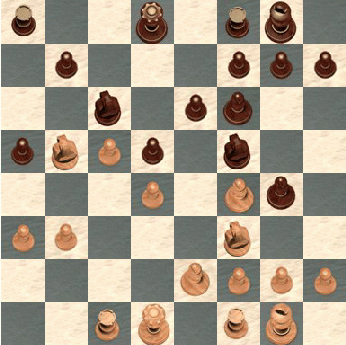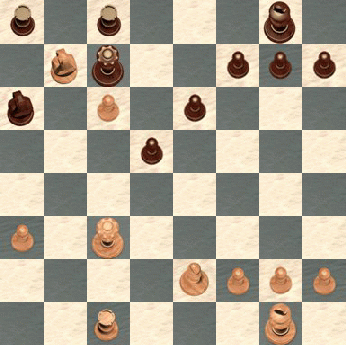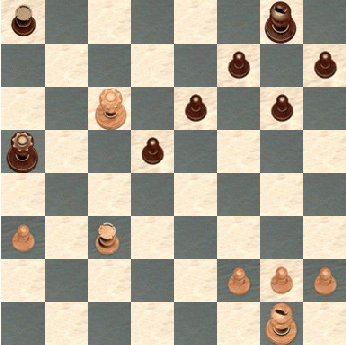1. e4, Nf6;
2. e5, Nd5;
3. d4, d6;
4. Nf3, Bg4;
5. Be2, e6;
6. 0-0, Be7;
7. c4, Nb6;
8. Be3,
Unconventional, but not refutable. Normally one would play 8.Nc3, or even
8.h3. These inversions are not harmful in this position, but it gave me
the impression that this game was not going to be a duel on the most beaten
paths of the modern variation of the Alechin defence. I was right, as the
next move shows.
9. ..., 0-0;
9. Nbd2,
This move cannot be a great one. The knight is much better posted in c3,
and indeed in this game white will later spend two more moves to get it to
that square.
9. ..., Nc6;
10. exd6,
Here a game R.Gunawan-E.Solozhenkin (New York Open, 1994) went instead
10.h3,Bh5; 11.exd6,cxd6; 12.Qb3,d5; 13.c5,Bxf3; 14.Bxf3,Na5; 15.Qc3,Nbc4;
16.Nxc4,Nxc4; 17.Be2,Nxe3; 18.Qxe3,a5; 19.b3,b6; 20.c6,Qd6; and white won
at the 41st.
10. ..., cxd6;
11. Rc1, Bf5!;
The bishop has to control the square e4, to prevent a white knight from
jumping there when black's darksquare bishop gets to f6.
12. a3N,
This is new to me. A game D.Kontic-A.Delchev went instead 12.Qb3,Bf6;
13.Rfd1,Qd7; 14.d5,Na5; 15.Qb4,Qa4; 16.a3,Bc2; 17.Rxc2,Qxc2; 18.Qxa5,Nxc4;
19.Nxc4,Qxe2; 20.Rc1,Rac8; 21.b3,Qd3; 22.Rf1,exd5; 23.Nxd6,Rc3; 24.Qxa7,
draw agreed. Fritz seems to like 12.Qb3 too. My over-the-board thinking
was concentrated on the complicated 12.d5!?, with the following possible
variation: 12....,exd5; 13.Bxb6,Qxb6; 14.cxd5,Ne5; 15.Nxe5,dxe5; 16.Nc4,Qd4;
17.d6,Bg5; 18.Qxd4,exd4; 19.f4,Bf6; 20.g4,d3! with a balanced position.
12. ..., a5;
13. b3,
Not a bad move, but I was expecting 13.Re1, where I had two alternatives:
(A) 13....,Rc8; 14.b3,d5; 15.c5,Nd7; 16.Nf1,e5 (or 16....,Bg6
17.Ng3,Qc7; 18.Qd2 with a slight edge to white); 17.dxe5,Ndxe5; 18.Nxe5,Nxe5;
19.Bd4, and white is slightly better;
(B) 13....,d5!; 14.c5,Nc8; 15.Qa4,N8a7; 16.Bf4,Bf6; 17.Bd6,Re8; with
unclear play.
13. ..., d5;
The thematic push.
14. c5, Nc8;
14....,Nd7; was also playable: 15.Re1,Re8; 16.Nf1,Bf6; 17.Ng3,Bg6
gives even chances.
15. Nb1,
Here my opponent humbly decided to relocate his badly posted knight.
In fact, the position of that piece is white's biggest problem.
I now used the two tempi to complete the development of my forces, since
I was not convinced too much of 15....,b6!; 16.Nc3,bxc5; 17.dxc5,Bf6;
that gave white a possibly weak but undoubtedly passed pawn on the queenside.
As a matter of fact, Fritz considers that position as slightly better for black.
15. ..., Bf6;
16. Nc3, N8e7;
17. Bf4,
Maybe worth a try was 17.Nb5!?, but black has just time enough to repel the
wing attack with 17....,Be4; 18.Nd6,Nf5!; 19.Nxf5 (19.Nxb7,Qe7 gives black
the edge),Bxf5; and black is ok.
17. ..., Bg4;
18. Nb5,
I had prepared to counter 18.Ne5 with 18....,Bxe2; 19.Nxe2,Bxe5; 20.Bxe5,dxe5;
but I actually was hoping for the jump in b5... I had analyzed a lot of
variations, and I knew it could be attractive for white but was
carrying no real threats to my position...
18. ..., Nf5;
At this point I was very satisfied with my plan of a circular attack of the
white pawn on d4, a standard theme that rarely needs to be carried out to
its extreme conclusions...

19. Bd6?,
This is surely bad. The wise thing would have been the humble
19.Be3, that could have been followed by 19...,a4 (19....,Qd7; 20.h3,Bxf3;
21.e5;22.Nc3,e4; 23.Bg4 is better for white);
20.b4,Qd7; 21.Qd3, with unclear play. But 19.Bc7 was also possible, with
the followup 19...,Qd7; 20.Ne5,Nxe5; 21.Bxe5,Bxe5; 22.dxe5,Bxe2; 23.Qxe2
with a drawish position.
19. ..., Nxd6;
20. Nxd6,
If instead 20.cxd6,Bxf3; 21.Bxf3,Na7; 22.Nxa7,Rxa7; black is
definitely better.
20. ..., Bxf3;
21. Bxf3, Bxd4;
And finally the d4 pawn falls. The capture with the bishop is as good
as was 21....,Nxd4; 22.Nxb7,Qb8; 23.c6,Rc8. I thought for a long
time this move, and came to the conclusion that they are equal in strength.
Fritz 5, given 5 minutes to analyze the position, gives to both a score
of plus 1.34 for black.
A matter of taste ? I think so.
22. b4!?,
The other possibility was 22.Nxb7,Qb8; 23.Nd6,Bb2! and black wins.
22. ..., Bb2?!
This move is a bit too greedy.
Much easier -and stronger- would have been 22....axb4; 23.axb4,Be5!
23. b5?,
According to Fritz the best for white was 23.Rb1,Bxa3; 24.b5,Ne5; 25.Nxb7,Qc7;
26.c6,Bb4; when the pawns look threatening like in the game, but white
has not given up the exchange to get there. To be honest, my feelings towards
23.b5 are mixed. It is evidently bad, but in the game I was not able to
refute it clearly, and slipped little by little in a position still won but
very difficult to handle with the clock ticking...
23. ..., Bxc1;
24. Qxc1, Nd4;
25. Nxb7, Qb8;
Fritz believes that the bold 25....,Qf6! would have been better:
26.b6,Nxf3+; 27.gxf3,Rc8; and black is safe despite the threatening look
of white's constellation on the queenside. I may agree, but during the
game I saw the other variation quite in depth, and decided that grabbing
one more pawn on the queenside would have given me much more confidence.
26. c6, Nxb5;
27. Qc5, Nc7;
28. Be2,
According to Fritz, 28.Rc1 would have been more accurate, but only by microns.
It could be followed by 28....,Rc8; 29.Be2,Ne8; 30.Bd3,Qf4; 31.Rc2,a4.
28. ..., Na6;
Fritz suggests 28....,Qa7; 29.Qc3,f6; 30.Rc1,e5; it can well be another
good plan, but I don't like
such early weakenings of the white squares. Better to solve the problem
of white's c6 pawn before committing to anything in my opinion... But
Fritz is probably right: black should try some active play somewhere,
otherwise it's not easy to disentangle from the grip of the passed pawn.
29. Qxa5, Qc7;
30. Qc3, Rfc8;
31. Rc1,

31. ..., Qb6?;
Damn it, I was starting to be short of time and who knows why I did this
ugly move. It wastes a good part of my advantage if white plays correctly...
The right plan was 31....,Nb8; 32.Bb5,Qe7; 33.Na5,Qa7; 34.Nb3,Qxa3; 35.c7,Na6;
36.Ra1,Rxc7; 37.Qxg7+,Kxg7; 38.Rxa3,Rca7 with a win for black.
Now, instead, he can control the queening square with the knight, and everything
start to be difficult.
32. Nd6, Rd8;
33. Bxa6, Qxa6;
34. c7?,
Thank god, if you have one. Better would have been 34.Qc5,h6; 35.a4,d4;
36.c7,Rxd6; 37.c8=Q+,Qxc8;
38.Qxc8+,Rxc8; 39.Rxc8+,Kh7; 40.Kf1, and I leave to you the judgement of
this ending... Is it won ? Is it not ? I surely can't tell. Fritz 5 does
not play very well these kind of positions, and gives black only a half pawn's
advantage... Can't believe the stupid machine. Quantify! Quantify! And
knowledge is lost.
34. ..., Qxd6!;
35. cxd8=Q+, Qxd8;
36. Qc5, g6;
The buddy here gives 36....,Qf8!; 37.Qxf8+,Kxf8; 38.Rc3,Ke7; 39.Kf1,Ra4
with an easy win. Of course it's right, but I had a minute or so to make
five more moves, and the idea of getting mated on the back rank didn't appeal
to me very much.
37. Rc3, Qa5;
38. Qc6,

38. ..., Qa4!;
Again, Fritz disagrees with my style. I like Qa4 so much I put an exclamative
mark on it, and the machine says that 38....,d4;39.Rc1,Qxa3; was better.
Oh well... Sure, you gain a pawn. But Qa4 goes in an ending I can play
blindfold, while in his variation we still got 2 queens on the board.
I really believe 90% of players would choose Qa4. Tell me what you think.
39. Qxa4, Rxa4;
40. g3, Kg7;
41. f4, Kf6;
42. Kg2, Kf5;
43. Kf3, h5;
44. h3,
Hoping for 44....,f6????????; 45.g4 mate!! Bad boy!
44. ..., g5!;
Not intrinsically a exceptionally strong move, but I like a lot the hopelessness
of white's position, and this simple move is the key to a quick win. Hey,
this is _my_ web page and _I_ put exclamation marks where I like them!
45. fxg5, Kxg5;
46. Rd3, Kf5;
47. Ke3, f6;
48. Kf3, d4;
49. g4+, hxg4;
50. hxg4+, Ke5;
51. Rb3, Kd5;
52. White resigns.